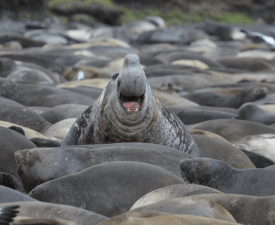Offspring sex ratio and paternal reproductive successs

During my PhD at the Université du Québec à Montréal (2017–2023), under the supervision of Dr. Denis Réale and co-supervision of Dr. Christophe Guinet (Centre d’Études Biologiques de Chizé) and Dr. Samantha Patrick (University of Liverpool), I had the opportunity to explore fascinating questions about the reproductive strategies of southern elephant seals (Mirounga leonina). One of my projects focused on understanding how paternal reproductive success influences the sex ratio of offspring in this highly polygynous species.
Why study offspring sex ratio?

In many animal species, the sex ratio of offspring can vary depending on environmental, social, and parental factors. This phenomenon is particularly interesting in polygynous species like southern elephant seals, where a small number of dominant males sire most of the offspring. Understanding how and why parents might adjust the sex of their offspring can provide insights into evolutionary strategies that maximize reproductive success.
The Trivers-Willard hypothesis suggests that parents in good condition or with high reproductive success may favor producing sons, as males have the potential for greater reproductive success in polygynous systems. On the other hand, parents with lower success might benefit from producing daughters, who have a more consistent chance of reproducing. My research tested this hypothesis in a colony of southern elephant seals breeding on the Kerguelen Archipelago.
How we conducted the study
To investigate this, we collected data from a southern elephant seal colony at the Rivière du Nord site on the Kerguelen Archipelago during the 2017 breeding season. We identified and sampled 74 breeding males and sexed and sampled 951 weaned pups the following year. Genetic analyses were performed using microsatellite markers to assign paternity with high confidence.
We also measured the body length of males as a proxy for age and physical condition, as these factors are known to influence dominance and reproductive success. Statistical models were used to analyze the relationship between paternal reproductive success and the likelihood of siring sons, accounting for factors like male tenure at the breeding site.
Key findings

Using genetic markers to assign paternity to 540 pups from 58 breeding males, we found that males with higher reproductive success were more likely to sire sons. Specifically, the probability of producing a son increased from 43% for males with low reproductive success to 54% for the most successful males. This supports the idea that offspring sex ratio adjustment is an adaptive strategy in this species.
Interestingly, while the overall sex ratio of weaned pups in the colony was balanced (50:50), the variation in sex ratio at the individual level was linked to the father’s reproductive success. This finding highlights the complex interplay between parental traits and reproductive strategies in shaping population dynamics.
Why this matters
This study provides evidence that paternal traits, particularly reproductive success, can influence offspring sex ratio in a wild mammal population. In southern elephant seals, where only a small fraction of males achieves high reproductive success, this adjustment may help stabilize fitness variance among males and prevent extreme reproductive skew. It also raises intriguing questions about the mechanisms behind this adjustment—whether it is driven by males, females, or both.
Looking ahead

This work opens the door to further research on the ecological and evolutionary factors influencing offspring sex ratio in polygynous species. Future studies could explore the physiological mechanisms behind sex ratio adjustment and how environmental changes might impact these dynamics. Understanding these processes is not only fascinating from an evolutionary perspective but also critical for the conservation and management of wildlife populations.
Acknowledgments
This project would not have been possible without the support of many individuals and institutions. Fieldwork on the Kerguelen Archipelago was supported by the Institut Polaire Français Paul-Émile Victor (IPEV) and the Centre d’Études Biologiques de Chizé. I also thank the many field assistants and volunteers who helped collect data, as well as the laboratory teams who supported the genetic analyses. This research was funded by the Natural Sciences and Engineering Research Council of Canada (NSERC), the Fond de Recherche du Québec - Nature et Technologies (FRQNT), and the French National Centre for Scientific Research (CNRS).
